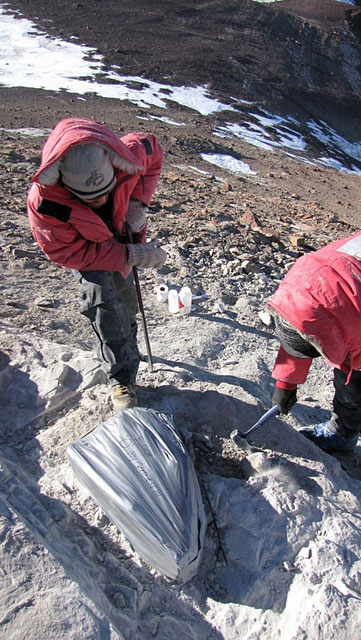Dawn of an ageEarly Triassic fossils provide clues to the rise of mammals, dinosaursPosted April 15, 2011
It’s the greatest murder mystery in the history of the planet. About 250 million years ago, life on Earth collapsed. More than 90 percent of the organisms in the ocean disappeared. Some 70 percent of land animals also died off. It all happened in a geological heartbeat, though there is some debate on the actual duration, as well as whether life flatlined all at once or in waves. Clues as to how the Permian-Triassic (P-T) extinction unfolded can be found in fossils entombed in the hard sedimentary rock of the central Transantarctic Mountains, one of the world’s longest ranges, which bisects Antarctica’s two great ice sheets. Caught on Video
Watch the field team at work in this YouTube video.
Several teams of paleontologists spent part of the austral summer there, flying and hiking among the peaks and outcrops to collect the rare and unusual bones of vertebrates that once burrowed and bounded across a much different landscape — including at least one never before found on the icy continent. “What we’re doing is recording what happened on land step by step, almost blow by blow, about what happened to cause the extinction,” explained Roger Smith “These animals adapt to the environments. By looking at the animal, we can get some indication of what the environment was like,” added Smith, a member of a team collecting everything from mammal-like therapsids from the Early Triassic to dinosaurs that lived in the region during the Jurassic, a stretch of time about 100 million years long. Smith, co-principal investigator Chris Sidor What caused the Great Dying, as the P-T boundary is sometimes called, is the big mystery. At the time, all of the landmasses had pushed and shoved together into a supercontinent called Pangaea, which would have caused changes in ocean and atmospheric circulation. The vast interior may have become extremely arid. There is evidence that the oceans had turned anoxic, nearly depleted of oxygen, at the end of the Permian. Extreme volcanism may have triggered greenhouse conditions that would have caused planetary temperatures to rise, as well as acidify the ocean. Similar environmental changes are happening today. Based on specimens the Karoo Basin in Africa, where Smith has worked for nearly three decades, he believes drought was the major cause of death across Pangaea. But the exact cause of that drought — supercontinent assembly, volcanism, shifting circulation patterns, or even an impact event — is not within the scope of this project. In fact, the scientists are just as fascinated with the flip side of the P-T extinction – recovery. “The way in which nature bounces back is just as intriguing as the extinction event itself,” Smith said. For example, a type of therapsid known as Lystrosaurus bolted out of the gate from the Late Permian into the Early Triassic, becoming the most common animal of the time. These and other mammal-like therapsids, which combined reptilian characteristics with some mammalian features such as canine teeth, were able to survive whatever catastrophe befell the world at the P-T boundary. And that’s a good thing for us, according to Huttenlocker. “Eventually, they gave rise to mammals in the Late Triassic,” he said. It also helped that the gorgonopsians, another type of large carnivorous therapsid that ruled during the Permian, took a big blow during the extinction. “They basically ruled the land. If they hadn’t been given this tremendous knock, there would have been no [ecological] space for the others to come through, especially the ones that led to humans,” Smith said. It’s also after the P-T extinction that the first of the common ancestors of dinosaurs arose. And one of the few and most complete specimens of these archosauromorphs, called Prolacerta, was discovered this season at a site called Graphite Peak.1 2 Next |



For USAP Participants |
For The Public |
For Researchers and EducatorsContact UsU.S. National Science FoundationOffice of Polar Programs Geosciences Directorate 2415 Eisenhower Avenue, Suite W7100 Alexandria, VA 22314 Sign up for the NSF Office of Polar Programs newsletter and events. Feedback Form |



